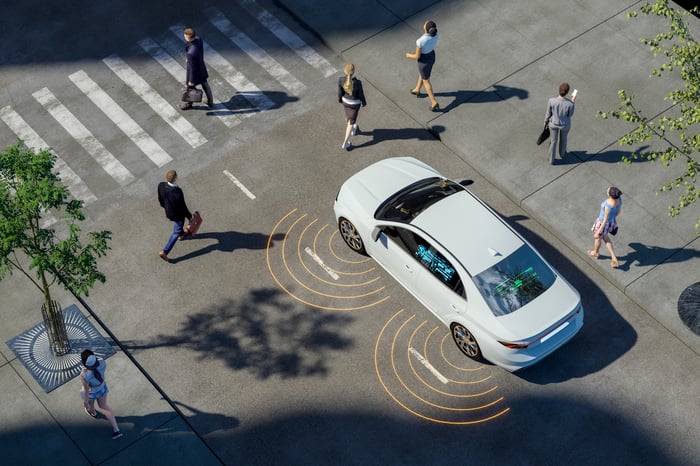1 Glorious Growth Stock That Could Turn $200,000 Into $1 Million by 2035
Uber Technologies (NYSE: UBER) operates the world's largest ride-hailing network, along with popular food delivery and commercial freight services. It relies on 8.5 million drivers and couriers to fulfill demand from its 170 million monthly active customers, but the company is on the cusp of a major shift that could transform its financial results.
Uber has signed partnerships with 18 companies that develop autonomous cars, robots, and even aircraft, and that list is growing. Since human drivers are the company's largest cost, these deals could result in billions of dollars in savings every year, which will flow through to Uber's revenue and its bottom line.
Where to invest $1,000 right now? Our analyst team just revealed what they believe are the 10 best stocks to buy right now. Learn More »
In fact, I think Uber stock could soar fivefold within the next decade thanks to autonomous technologies. Here's how it could turn a $200,000 investment into $1 million by 2035.

Image source: Getty Images.
Autonomous driving could reshape Uber's business
During the first quarter of 2025 (ended March 31), Uber reported $42.8 billion in gross bookings, which was the dollar value of every trip, food order, and commercial delivery the platform facilitated on behalf of its customers. The $18.6 billion drivers and couriers earned during the quarter was the single-largest component of the gross bookings figure.
After deducting a further $12.9 billion in merchant payouts (money paid to restaurants for customers' food orders, as an example), Uber was left with $11.5 billion in revenue. Then, once the company factored in operating costs like marketing and research and development, its net income (profit) for the quarter came in at $1.7 billion on a generally accepted accounting principles (GAAP) basis.
In other words, Uber doesn't get to keep a whole lot of the money customers spend on its platform. That's why autonomous vehicles have the potential to transform its economics -- if self-driving cars and robots reduce Uber's reliance on human drivers, the company could pocket an additional $18.6 billion from its gross bookings each quarter (based on its Q1 result).
Uber would have to pay some of that money to the companies deploying their self-driving cars into its network, but since they can operate 24/7, the economics are still likely to be significantly better than using human drivers. Plus, Uber could choose to buy a fleet of autonomous vehicles and operate them itself, which would be even more profitable over the long term.
A growing list of autonomous partnerships
In his prepared remarks to shareholders for the 2025 first quarter, CEO Dara Khosrowshahi said Uber had partnerships with 18 different providers of autonomous vehicles, up from 14 just six months earlier. Simply put, developers want to deploy their vehicles into the mobility network with the most users so they can maximize their revenue, which gives Uber a distinct advantage over the competition.
Many of those partnerships are already producing results, because Uber is now facilitating around 1.5 million autonomous trips per year (annualized based on its Q1 results). Many of those are attributable to Alphabet's Waymo, which is completing over 250,000 paid autonomous trips per week -- some through its own ride-hailing service, and some through Uber.
Waymo has been operating in Phoenix, Los Angeles, and San Francisco, but it entered Austin, Texas, in March as part of an exclusive deal with Uber. It has 100 autonomous vehicles available in that market right now, and Uber says they are busier than 99% of the platform's human drivers in the area. The two companies will deploy hundreds more driverless cars in Austin over the next few months, and they plan to expand into Atlanta.
Waymo is already a raging success, but Uber wants to help its other autonomous partners commercialize their technologies more quickly, because they have so much potential to save the company money on human drivers. As a result, it entered a unique partnership with Nvidia earlier this year, which is the world's leading supplier of chips and software for artificial intelligence (AI) development.
Uber will use Nvidia's DGX Cloud supercomputer platform to process data from the billions of trips it facilitates each year, which will help its autonomous partners create more powerful self-driving models. Uber will also use Nvidia's Cosmos foundation models to create real-world training simulations, which will speed up the development process even further.
Turning $200,000 into $1 million by 2035
Based on Uber's trailing-12-month revenue of $45.3 billion and its market capitalization of $174 billion, its stock trades at a price-to-sales (P/S) ratio of around 4, as of this writing. That's a slight discount to its average of 4.2, dating back to when the company went public in 2019:

UBER PS Ratio data by YCharts
If we assume Uber's P/S ratio remains constant at 4, the company will need to generate around $226.5 billion in annual revenue by 2035 to justify a fivefold return in its stock. That translates to a compound annual growth rate of 17.5% over the next decade. Between 2017 and 2024, Uber actually grew its revenue at a much faster annual rate of 27.7%, which suggests it should have no trouble hitting the mark.
However, it becomes harder for Uber to grow that quickly as its revenue base becomes larger. According to Wall Street's consensus estimate (provided by Yahoo! Finance), the company is expected to grow its revenue by just 14% annually for the next two years. If that trend continues, it could take much longer than a decade for Uber stock to turn an investment of $200,000 into $1 million.
But remember this: Uber stands to pocket an extra $18 billion every quarter if it can eliminate human drivers completely. It certainly won't happen overnight, but the gradual shift toward autonomous vehicles could be a monumental tailwind for its revenue for the next several years. In fact, Khosrowshahi thinks the autonomous opportunity will be worth over $1 trillion to Uber in the U.S. alone.
Therefore, while it's possible Uber delivers below-trend revenue growth for the next couple of years, it could accelerate later this decade (and beyond) as more self-driving cars hit the road. As long as the company's revenue growth averages 17.5% over the next 10 years, it will lay the foundation for a fivefold return in its stock.
Should you invest $1,000 in Uber Technologies right now?
Before you buy stock in Uber Technologies, consider this:
The Motley Fool Stock Advisor analyst team just identified what they believe are the 10 best stocks for investors to buy now… and Uber Technologies wasn’t one of them. The 10 stocks that made the cut could produce monster returns in the coming years.
Consider when Netflix made this list on December 17, 2004... if you invested $1,000 at the time of our recommendation, you’d have $617,181!* Or when Nvidia made this list on April 15, 2005... if you invested $1,000 at the time of our recommendation, you’d have $719,371!*
Now, it’s worth noting Stock Advisor’s total average return is 909% — a market-crushing outperformance compared to 163% for the S&P 500. Don’t miss out on the latest top 10 list, available when you join Stock Advisor.
See the 10 stocks »
*Stock Advisor returns as of May 5, 2025
Suzanne Frey, an executive at Alphabet, is a member of The Motley Fool's board of directors. Anthony Di Pizio has no position in any of the stocks mentioned. The Motley Fool has positions in and recommends Alphabet, Nvidia, and Uber Technologies. The Motley Fool has a disclosure policy.



